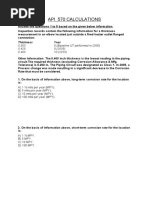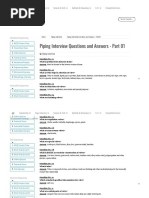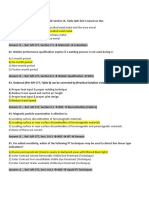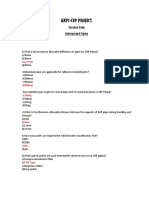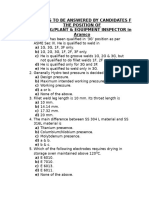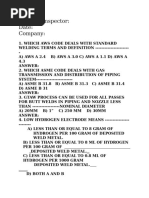0 ratings0% found this document useful (0 votes)
58 viewsPiping Final Exam
Piping Final Exam
Uploaded by
Ahmed Haridi1. The document lists exam questions about valves, piping, flanges, and inspection. It includes questions about valve and piping types, standards, testing, materials, connections, and inspection methods.
2. Questions cover topics like valve parts, tight-shutoff valves, regulating valves, pressure testing, piping materials, connections, flanges, supports, and inspection techniques like visual testing, ultrasonic testing, and radiography.
3. The document provides a comprehensive review of topics for an exam on valves, piping systems, and inspection methods.
Copyright:
© All Rights Reserved
Available Formats
Download as PDF, TXT or read online from Scribd
Piping Final Exam
Piping Final Exam
Uploaded by
Ahmed Haridi0 ratings0% found this document useful (0 votes)
58 views11 pages1. The document lists exam questions about valves, piping, flanges, and inspection. It includes questions about valve and piping types, standards, testing, materials, connections, and inspection methods.
2. Questions cover topics like valve parts, tight-shutoff valves, regulating valves, pressure testing, piping materials, connections, flanges, supports, and inspection techniques like visual testing, ultrasonic testing, and radiography.
3. The document provides a comprehensive review of topics for an exam on valves, piping systems, and inspection methods.
Original Title
Piping Final Exam
Copyright
© © All Rights Reserved
Available Formats
PDF, TXT or read online from Scribd
Share this document
Did you find this document useful?
Is this content inappropriate?
1. The document lists exam questions about valves, piping, flanges, and inspection. It includes questions about valve and piping types, standards, testing, materials, connections, and inspection methods.
2. Questions cover topics like valve parts, tight-shutoff valves, regulating valves, pressure testing, piping materials, connections, flanges, supports, and inspection techniques like visual testing, ultrasonic testing, and radiography.
3. The document provides a comprehensive review of topics for an exam on valves, piping systems, and inspection methods.
Copyright:
© All Rights Reserved
Available Formats
Download as PDF, TXT or read online from Scribd
Download as pdf or txt
0 ratings0% found this document useful (0 votes)
58 views11 pagesPiping Final Exam
Piping Final Exam
Uploaded by
Ahmed Haridi1. The document lists exam questions about valves, piping, flanges, and inspection. It includes questions about valve and piping types, standards, testing, materials, connections, and inspection methods.
2. Questions cover topics like valve parts, tight-shutoff valves, regulating valves, pressure testing, piping materials, connections, flanges, supports, and inspection techniques like visual testing, ultrasonic testing, and radiography.
3. The document provides a comprehensive review of topics for an exam on valves, piping systems, and inspection methods.
Copyright:
© All Rights Reserved
Available Formats
Download as PDF, TXT or read online from Scribd
Download as pdf or txt
You are on page 1of 11
EXAM QUESTIONS
1. Name 3 types of valves.
Gate valve/globe valve/ball valve/check valve/butterfly valve
2. Name 2 valve types that are recognized as tight shut-off.
Ball valve and plug valve
3. Name one manually operated valve that can be used for regulating
flow.
Globe valve
4. What API is applicable for the inspection and testing of valves?
API 598
5. Name 3 methods for attaching a valve to a piping system.
Butt-welded, flanged and threaded connections
6. Name 3 parts of a manually operated valve generally used in oil,
water and gas service.
Valve stem/valve body/valve bonnet/valve seat/hand wheel
7. Name what is normally shop pressure tested before a valve in critical
service is installed in the field
Gate valve
8. Name two applicable international standards applicable for the
manufacture of pipe.
ANSI/ASME B-31.1 and ASME B-31.3
9. Name 3 methods of attaching piping components together.
Butt-welded/ socket/ threaded/flanged/seal-welded
10. Name 3 types of flanges.
Weld neck/slip-on/threaded
11. Name 3 types of flange surfaces.
Raised face/ring type joint/flat face
12. What type of flange design would you expect to see in an 8-inch
valve operating in hydrocarbon service at 200 psig at 300 degrees
F? weld neck and/or slip-on type flanges
13. What type of flange design would you expect to see in an 8-inch
valve operating in low pressure water service (20 psig at 100
degrees F)? threaded flange
14. Name 3 methods for inspecting piping.
VT, UT and RT
15. Explain what pressure testing is required on a saddle reinforcement
connection after completion of welding.
Pneumatic test
16. Name 2 examples of forged piping components.
Elbows, tees, weld bosses etc…..
17. Name the applicable international standard for the in-plant
hydrocarbon piping inside the refinery.
ASME/ANSI B31.3 process piping
18. Name 2 ways that piping wall loss damage can occur in in-service
piping. Thinning by corrosion and corrosion/erosion
19. Name the applicable international standard for the piping that is
found going to and from the High Pressure Boilers in the refinery.
ASM/ANSI-B-31.1 power piping
20. What is the safety factor that is used in the design of regular
hydrocarbon piping inside a plant in the refinery?
3:1
21. How do you determine the pressure test for new flanged piping
components for a plant in the refinery? It is 1 1/2 times the 100 deg.
F rating rounded off to the next higher 25 psi increments
22. What methods can be used to determine piping service
integrity/reliability while the piping is in service?
23. What is Tmin?
24. What is TML stands for?
25. What is a piping deadleg?
26. Name the flange identification markings.
27. Name the reasons for insulating piping systems.
28. Name two piping materials used in sea water service?
29. Name two piping materials used in high temperature service above
750 deg. F in the presence of hydrogen sulfide.
30. Name two types of reinforced connections?
31. Name the flange type that can be used in all classes.
32. Name two types of piping supports.
33. Name two grades of carbon steel piping.
34. What is ERW pipe?
35. What is a joint efficiency?
36. When does the nominal pipe size become the actual outside
diameter for steel pipe?
37. What the acronym CUI stands for?
38. The rate of deterioration of a piping system depends on a number of
factors. Name two of these factors .
39. What is MAWP?
40. What is the preferred inspection method of injection points for
establishing TML’s?
41. What API standard outlines the methods and procedures for external
visual inspection of piping systems?
42. What is the purpose of pressure testing of plant piping and
equipment?
43. When a pressure relief devise is installed in the piping system to be
hydrotested and the test pressure is 1125 psi, what must the set
pressure of the relieve valve be?
44. A piping system is to undergo a hydrotest after an alteration, the test
pressure will be 450 psig. State if the correct gauge is utilized and
state the acceptable range of that gage. (Show your work)
45. What is the time table for testing a relief valve prior to using it in a
particular hydrotest?
46. When shall a pressure test be applied for a piping systems?
47. Name two types of pressure testing?
48. What is a hydrostatic test diagram as defined in SAES-A-004?
49. How is piping protected from overpressure during hydrotesting?
50. A gate valve is an example of a valve
a) Globe
b) Needle
c) Control
d) Block
51. A globe valve is commonly used to:
a) Prevent back flow
b) Allow full flow
c) Stop all flow
d) Regulate fluid flow
52. A check valve is commonly used to:
a) Prevent back flow
b) Allow flow
c) Stop all flow
d) Regulate fluid flow
53. The of a flange or a valve describes the pressure and the
temperature that it can withstand:
a) Size
b) Shape
c) Class
d) Color
54. A globe valve is a valve
a) Block
b) Throttling
c) Plug
d) Check
55. Every flange connection contains:
a) A gate valve
b) A tube
c) A needle valve
d) A gasket
56. Connections are preferred on permanent connections 2 inches and
larger
a) Socket-welded
b) Butt-welded
c) Threaded
d) Seal-welded
57. Pipes and fittings that are welded are
a) Screwed
b) Threaded
c) Beveled
d) Small
58. Flanged connections are often found on
a) Valves
b) Elbows
c) Tees
d) Unions
59. A butt-welded connection is the kind of connection
a) Weakest
b) Strongest
c) Smallest
d) Worst
60. Flanged connections are together
a) Bolted
b) Screwed
c) Welded
d) Cemented
61. Flanged connections can be disconnected by removing:
a) Nails
b) Nuts and bolts
c) Screws
d) Threads
62. Thin aluminum or covers piping insulation
a) Bronze
b) Carbon steel
c) Stainless steel
d) Copper
63. Insulation is secured by
a) Pipe slides
b) Pipe shoes
c) Bands
d) Expansion loops
64. Pipe shoes are attached to
a) Pipes
b) Stanchion
c) Expansion loops
d) Anchors
65. give(s) piping free space to move during temperature
changes
a) Insulation
b) Expansion loops
c) Mineral wools
d) Foam glass
66. Calcium silicate is a type of
a) Insulation materials
b) Pipe supports
c) Pipe shoes
d) Stanchions
67. The outside diameter of piping
a) Remains the same regardless of thickness
b) Varies with the pipe wall thickness
c) Is the same as the pipe size
d) Changes with the pipe schedule
68. Which of the following affects the strength of pipe material?
a) Grade
b) Heat treatment
c) Alloying material
d) All of the above
69. API covers inspection of:
a) New construction
b) New tank construction
c) Piping
d) Vessels
70. The primary purpose of inspection is to achieve the desired quality
assurance and:
a) Ensure plant safety
b) Supply the necessary paperwork for outside audits
c) Create an avenue for dismissing craftsmen
d) Ensure painting in good condition
71. The details of inspection of in-service piping are provided in:
a) ASME IX
b) ASME B31.3
c) API 570
d) ASME B16.5
72. T= PD/2SE is the formula for:
a) Required thickness
b) Maximum piping thickness
c) Arbitrary piping thickness
d) Average piping thickness
73. API 574 is a:
a) Code
b) Standard
c) Specification
d) Recommended practice
74. Socket weld should:
a) Be avoide in piping system
b) Be used in all welded piping
c) Be avoided in Saw welding only
d) Be avoided where crevice corrosion may occur
75. A soil-to-air interface is generally the zone from the soil surface.
a) 12” below and 6” above
b) 6” below and 12” above
c) 12” above and 6” below
d) All of the above
76. Prior to inspection, the Inspector should be familiar with:
a) The prior inspection result
b) Any repairs in the piping system
c) Review the history of piping system
d) All of the above
77. Typical sources of moisture that cause corrosion under insulation
include:
a) Breaks in insulation
b) Rain, water leaks, condensation and deluge system
c) Both A and B are correct
d) None of the above
78. Thickness measurements are taken to determine the condition and
the remaining life of a piping system. Thickness measurements can
be taken when:
a) The piping system is in operation
b) The piping system is out of service
c) Both A and B
d) None of the above
79. An external visual inspection is performed to determine the outside
condition of the piping including:
a) Insulation system
b) Painting and coating system
c) Associated hardware
d) All of the above
80. External inspections includes surveys of the condition of piping
hangers and supports, which item below is an inspection item:
a) Cracked or broken hanger
b) Bottoming out of spring support
c) Support shoe displaced from support member
d) All of the above
81. The TML’s should include measurements at:
a) The four quadrants on pipe and fitting
b) Inside and outside radius of elbows and tees
c) Both A and B
d) None of the above
82. A section of piping encompassed by flanges or other connected
fittings is called:
a) A flanged pipe
b) A ready to be installed pipe
c) A spooled piece
d) A fabricated assembly
83. Which of the following tests are not normally conducted as part of a
routine inspection:
a) UT thickness
b) Visual inspection
c) Radiography
d) Pressure test
84. During the installation of a flange, the bolts should:
a) Extend two threads past their nuts
b) Extend completely through their nuts
c) Extend only half way through their nuts
d) Extend at least .5 inches past their nuts
85. Procedures for segregating piping systems, installing blinds, and
testing the tightness should be an integral part of:
a) Preparatory work
b) Safety practice
c) Testing
d) Inspection
86. The most common forms of CUI are:
a) General corrosion of carbon steel
b) Stress corrosion cracking
c) Localized corrosion and stress corrosion cracking of stainless steel
d) Localized corrosion of carbon steel and stress corrosion cracking of
stainless steel
87. Piping can resist to various forms of corrosion by:
a) Upsetting the process condition of the system
b) Expose to wet hydrogen sulfide
c) Proper selection of construction material
d) Exposure to condensation
88. Which method (s) is used for determining thickness?
a) Radiography
b) Ultrasonic
c) Both A and B
d) None of the above
89. When pressure tests are conducted, it shall be in accordance with
the requirements of :
a) SAES-A-004
b) SAES-L-150
c) ASME-B31.3
d) All of the above
90. How often does injection point in a piping system inspected?
a) 6 years
b) 5 years
c) 4 years
d) 3 years
91. Pressure test normally required after alterations and major repairs.
When a pressure test is not necessary or practical,
a) NDT shall be utilized in lieu of a pressure test
b) Pneumatic test maybe applied
c) Both A and B
d) None of the above
92. Which of the following documents define the dimensions of welded
and seamless steel pipe?
a) ASME B31.3
b) ASTM B16.6
c) ASME B31.1
d) ASME B36.10M
93. What is the reason for inspecting piping system?
a) Ensure piping safety and reliability
b) Identify active deterioration mechanism
c) Predict future repairs or replacement
d) B and C above
94. Piping as used in petrochemical plant are frequently replaced due to
deterioration caused by:
a) Excessive vibration in the piping system
b) Thinning by corrosion
c) Cracks in the weld joints
d) None of the above
95. Piping system that are more susceptible to accelerated corrosion
rates in areas where:
a) Increase velocity and turbulence
b) The change of direction occurs
c) No flow occurs like in deadlegs
d) All of the above
96. Many condition assessments can be made when a piping system is
in service, these includes,
a) Pipe support systems
b) Leakage
c) Thickness measurements
d) All of the above
97. What is the long corrosion rate of a piping circuit that started at .375
inches and is now .1 inches, the measurements were taken over a
five year period. (Show your calculation)
98. Use Barlow’s ( t= PD/2SE) to calculate (t) for the following: (show
your work)
Process plant piping: seamless, sch 40, 6”, A-106 Gr.B, design pressure
600 psig, design temperature 650 degrees F.
Enter the value for the formula variables:
P=
D=
S=
E=
T (calculated)=
T str.=
99. Determine the remaining life for the following. Design pressure 600
psi @ 300 deg. F, material A-53-B-ERW pipe, NPS 6, sch.40. The
thickness at the last inspection was 0.157, the thickness from
previous inspection was .201, the inspection interval is 5 years.
(show your work)
100. Determine the retirement thickness for process plant piping, sch.40,
6”, A-106 Gr. B, design pressure 600 psig, design temperature 650
deg. F. (show your work)
Enter the value for the formula variables. ( t=PD/2SE)
P=
D=
S=
E=
101. What is the remaining life in years of a piping systems whose
corrosion rate is .074” per year, the actual wall thickness is 0.370”
and the required minimum thickness is .1”? (show your work).
You might also like
- Catalogo Carreg Mich 55C - 18000Document238 pagesCatalogo Carreg Mich 55C - 18000Nilton Junior Kern86% (22)
- ACDC - Practice Exercises 1 - Answer - KeyDocument12 pagesACDC - Practice Exercises 1 - Answer - KeyRommel AunarioNo ratings yet
- TROUBLESHOOTING / Troubleshooting A: Fault Code List MCDocument47 pagesTROUBLESHOOTING / Troubleshooting A: Fault Code List MCPoyraz Poyraz100% (1)
- ASME V QuestionsDocument19 pagesASME V QuestionsabdoNo ratings yet
- Basics of Piping EngineeringDocument43 pagesBasics of Piping EngineeringAyush100% (1)
- Resume SampleDocument4 pagesResume SampleGokulPrasadNo ratings yet
- API 570 Chapter10 Asme Ix RevDocument50 pagesAPI 570 Chapter10 Asme Ix RevFabio MiguelNo ratings yet
- (123doc) - Tai-Lieu-Thi-Tuyen-Loc-Dau-Nghi-Son-Piping-Assessment-Quesion12 PDFDocument17 pages(123doc) - Tai-Lieu-Thi-Tuyen-Loc-Dau-Nghi-Son-Piping-Assessment-Quesion12 PDFTrường Tùng LýNo ratings yet
- Piping Question and AnswerDocument7 pagesPiping Question and AnswerMohammed Abdul Moqeet100% (10)
- Aramco Piping QuestionsDocument6 pagesAramco Piping Questionschandu666creator90% (10)
- API 570 - Asme B31.3 Q&ADocument29 pagesAPI 570 - Asme B31.3 Q&AShaalan Ali100% (1)
- 804-904 Spare Parts Manual AMCO VEBA PDFDocument170 pages804-904 Spare Parts Manual AMCO VEBA PDFHidroil Neuquen Srl0% (1)
- Ee0041l-Finals (Sa) VillanuevaDocument86 pagesEe0041l-Finals (Sa) VillanuevaKYLE LEIGHZANDER VICENTENo ratings yet
- Cat Data Link - Test: TroubleshootingDocument8 pagesCat Data Link - Test: Troubleshootingmiguel oswaldo gonzalez benitezNo ratings yet
- Piping InterviewDocument9 pagesPiping Interviewsatyammmishra0101No ratings yet
- 5 6327619470013497820Document4 pages5 6327619470013497820shaijukvNo ratings yet
- Pipe Fittings and Piping AuxiliariesDocument38 pagesPipe Fittings and Piping Auxiliariesmsaad2100% (1)
- TDS PDF Intertherm - 751CSADocument4 pagesTDS PDF Intertherm - 751CSAwilliam sukyonoNo ratings yet
- Questions For RTR Piping, RTR PipingDocument4 pagesQuestions For RTR Piping, RTR Pipingg s b srinivasNo ratings yet
- Valve QuestionDocument3 pagesValve Questionmitesh100% (1)
- All Piping Interview Questions and AnswersDocument58 pagesAll Piping Interview Questions and Answersdk sharmaNo ratings yet
- 5 6327619470013497827Document4 pages5 6327619470013497827shaijukvNo ratings yet
- API 570 Questions 07Document20 pagesAPI 570 Questions 07Ravindra S. Jivani100% (1)
- WPS SummaryDocument33 pagesWPS SummaryMidhun K ChandraboseNo ratings yet
- 12.lifting Lugs Are Attached To Joints With Structure? 1-Primary Members 2. SecondaryDocument2 pages12.lifting Lugs Are Attached To Joints With Structure? 1-Primary Members 2. Secondaryshoaib2scribed100% (1)
- Piping Inspectors Aramco QuestionnaireDocument2 pagesPiping Inspectors Aramco Questionnairemustafa abdelshafiNo ratings yet
- Paper-01Document7 pagesPaper-01Muhammad QasimNo ratings yet
- Questions & Answers: NDT Viernes, 15 de Septiembre de 2017Document7 pagesQuestions & Answers: NDT Viernes, 15 de Septiembre de 2017Percy Junior Berrios MuñozNo ratings yet
- Westermann Tables PDFDocument12 pagesWestermann Tables PDFbayupranotostNo ratings yet
- Piping Interview QuestionsDocument4 pagesPiping Interview Questionsprabhjyot_uclNo ratings yet
- Api 570 - 02 Asme B 31.3Document12 pagesApi 570 - 02 Asme B 31.3Mohammad RawoofNo ratings yet
- Piping, Hydro QC List-InterviewDocument8 pagesPiping, Hydro QC List-Interviewtayyab100% (1)
- CBT QuestionsDocument5 pagesCBT QuestionsMunirathnamNo ratings yet
- PipingDocument17 pagesPipingHarshal Shah100% (1)
- 60 +piping Engineering Interview QuestionsDocument8 pages60 +piping Engineering Interview QuestionsDENYSNo ratings yet
- Api 570 Calculations Final Nov 2020Document10 pagesApi 570 Calculations Final Nov 2020HARDIK PATEL100% (2)
- Piping Interview Questionnaire 5Document2 pagesPiping Interview Questionnaire 5Valli RajuNo ratings yet
- Sa (Valves and Fittings Exam)Document6 pagesSa (Valves and Fittings Exam)rajaksekar100% (2)
- Piping Interview Question Answers For Oil and Gas CompaniesDocument5 pagesPiping Interview Question Answers For Oil and Gas CompaniesAamir KhanNo ratings yet
- Dimensional & Material Standards For Piping ComponentsDocument3 pagesDimensional & Material Standards For Piping ComponentsaasattiNo ratings yet
- Piping Interview Questions and Answers - Part 01Document5 pagesPiping Interview Questions and Answers - Part 01Jose LuisNo ratings yet
- 1 SS PP 005Document18 pages1 SS PP 005sanketNo ratings yet
- Piping & Piping ComponentsDocument39 pagesPiping & Piping ComponentsRamesh mudunuri100% (1)
- 010-Attending An Interview For A Pressure Vessel Inspector Here Are Some Essential Questions To AnticipateDocument15 pages010-Attending An Interview For A Pressure Vessel Inspector Here Are Some Essential Questions To AnticipateInstech Premier Sdn BhdNo ratings yet
- Piping Interview QSTNDocument8 pagesPiping Interview QSTNEzhil ArasanNo ratings yet
- MCQ's Tips Paper 1Document3 pagesMCQ's Tips Paper 1miteshNo ratings yet
- Piping Engineer B2 PDFDocument1 pagePiping Engineer B2 PDFAniz DonuTz100% (1)
- Assessment To API 579 Part 4: General Metal Loss. Point Thickness ReadingsDocument2 pagesAssessment To API 579 Part 4: General Metal Loss. Point Thickness ReadingsSyafiqah IsmailNo ratings yet
- Undercut (Per API 577, Table 6) Can Be Corrected by (Practical Solution Column)Document2 pagesUndercut (Per API 577, Table 6) Can Be Corrected by (Practical Solution Column)korichi100% (1)
- Lijo Johnson - Api Inspector - 510 - CVDocument5 pagesLijo Johnson - Api Inspector - 510 - CVonline M100% (1)
- Date: Name SurnameDocument3 pagesDate: Name Surnamekta_87100% (1)
- Pipeline and Piping Inspection, Maintenance, Repair & Integrity AssessmentDocument7 pagesPipeline and Piping Inspection, Maintenance, Repair & Integrity Assessmentamr habibNo ratings yet
- Piping Engineer ResponsibilitiesDocument1 pagePiping Engineer ResponsibilitiesRajvachan ManiNo ratings yet
- Joint EfficiencyDocument2 pagesJoint EfficiencyahmaddanielmatshahNo ratings yet
- PipingDocument8 pagesPipingRajkumar ANo ratings yet
- Glossary of Pipe StandardsDocument4 pagesGlossary of Pipe StandardsrahulNo ratings yet
- KNPC-CFP Project: Question Bank Underground PipingDocument12 pagesKNPC-CFP Project: Question Bank Underground PipingAnil TiwariNo ratings yet
- Important Process Piping QuestionsDocument12 pagesImportant Process Piping Questionspratap biswas100% (1)
- GT Technical & Management Institute PVT LTD Info@globaltraining - in API Inspector CV1 (Mathavaraja Ganesan)Document7 pagesGT Technical & Management Institute PVT LTD Info@globaltraining - in API Inspector CV1 (Mathavaraja Ganesan)Ganesan RamamoorthyNo ratings yet
- Piping QuizDocument20 pagesPiping QuizAlex CarreraNo ratings yet
- API.570. Closed Book 3Document31 pagesAPI.570. Closed Book 3Siva KumarNo ratings yet
- API 570 Exam June 1Document24 pagesAPI 570 Exam June 1Sudarshan79% (14)
- QDocument12 pagesQJoseph Peter100% (1)
- API 570 Closed Book 6 Exam QuestionsDocument21 pagesAPI 570 Closed Book 6 Exam QuestionsFares ÆazizNo ratings yet
- Lesson 3 Piping Inspector Q & ADocument6 pagesLesson 3 Piping Inspector Q & Alodhiahsan692No ratings yet
- B31.3 QuestionsDocument17 pagesB31.3 Questionsemaanazeem67% (6)
- Fit-Up InspectionDocument23 pagesFit-Up InspectionAhmed HaridiNo ratings yet
- bGAS Study QPDocument25 pagesbGAS Study QPAhmed HaridiNo ratings yet
- Welding Q6Document14 pagesWelding Q6Ahmed HaridiNo ratings yet
- Welding Q4Document13 pagesWelding Q4Ahmed HaridiNo ratings yet
- 12 - Ch-08 Measurement Results0326Document10 pages12 - Ch-08 Measurement Results0326Nguyễn Danh DungNo ratings yet
- Denn Optimization by Variational MethodsDocument431 pagesDenn Optimization by Variational Methodsksch123No ratings yet
- Cob Led Spot 12 W 3000 K RD: Product DatasheetDocument3 pagesCob Led Spot 12 W 3000 K RD: Product DatasheetAchmad SaechudinNo ratings yet
- Three-Phase Induction Motors PDFDocument32 pagesThree-Phase Induction Motors PDFDimitriu CarmenNo ratings yet
- Hopkinson Test On DC Shunt MotorDocument5 pagesHopkinson Test On DC Shunt MotorVarun VadluriNo ratings yet
- Oracle DBA Questions PDFDocument11 pagesOracle DBA Questions PDFsellenduNo ratings yet
- Mnemonic Devices For The Awesomeness That Is ChemistryDocument3 pagesMnemonic Devices For The Awesomeness That Is ChemistryAnupamNo ratings yet
- Self-Assessment Check Activity TemplateDocument2 pagesSelf-Assessment Check Activity TemplatedanielbragaisNo ratings yet
- Horno de Microondas Sharp R481cwaDocument40 pagesHorno de Microondas Sharp R481cwaErick RodriguezNo ratings yet
- Tagum Bid FormDocument7 pagesTagum Bid FormBing MarvzNo ratings yet
- System Operation of ARC Braking System 777D and 773DDocument8 pagesSystem Operation of ARC Braking System 777D and 773Dzawmoe aungNo ratings yet
- Bapi Inspoper RecordresultsDocument3 pagesBapi Inspoper RecordresultsvtheamthNo ratings yet
- Ivo Na 1204Document33 pagesIvo Na 1204Marco MachadoNo ratings yet
- Wood Stone Structure Plans v1 LandscapeDocument100 pagesWood Stone Structure Plans v1 Landscapelourandinc_746037853No ratings yet
- Class 5 CANopen GuideDocument234 pagesClass 5 CANopen GuideanypatyluNo ratings yet
- Metrology Comparators Unit 7Document36 pagesMetrology Comparators Unit 7Santhosh Kumar100% (1)
- Projection of Points and LinesDocument45 pagesProjection of Points and LinesYash JaiswalNo ratings yet
- Rosso60 100Document10 pagesRosso60 100José SilvaNo ratings yet
- Cotiviti JNF For BE 2022-23Document2 pagesCotiviti JNF For BE 2022-23aditya tathagathNo ratings yet
- Assembly+instruction England 50000220 50000223 50001420 2023 04Document18 pagesAssembly+instruction England 50000220 50000223 50001420 2023 04Ryan LeisNo ratings yet
- BXUV.N862 Fire-Resistance Ratings - ANSI/UL 263 Design/System/Construction/Assembly Usage DisclaimerDocument2 pagesBXUV.N862 Fire-Resistance Ratings - ANSI/UL 263 Design/System/Construction/Assembly Usage DisclaimerLAWNo ratings yet
- OHVDocument2 pagesOHVQuốc Khởi NguyễnNo ratings yet
- 1 s2.0 S016766361830557X MainDocument11 pages1 s2.0 S016766361830557X Mainvignesh ponnusamyNo ratings yet
- Polymers in Drilling FluidsDocument60 pagesPolymers in Drilling FluidsAlfredo RodriguezNo ratings yet



































